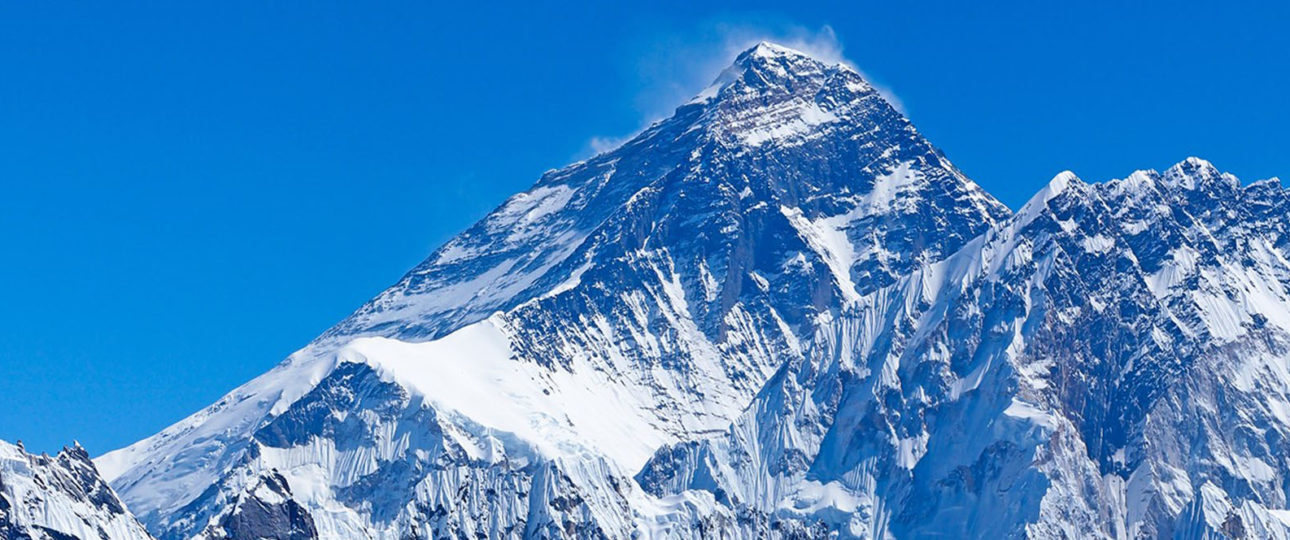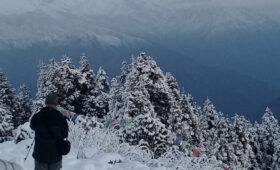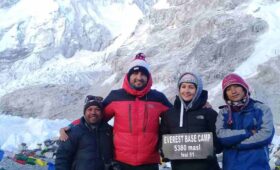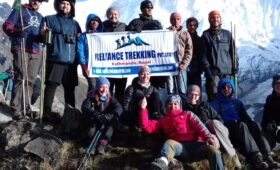The Everest Base Camp trek is on the top of every trekker’s bucket list. The foothill of the world’s highest mountain (5,380 m above sea level), Mt. Everest is not an easy voyage. However, the accessibility and grade of the trek make it achievable for those with decent health. Every year millions of trekkers try to conquer the mountain, however, underestimating the difficulty of executing the strenuous trek in the Everest region results in many failures. Thus, before embarking on this blissful journey, there is some preparation you need to do. This guide has listed a few tips and friendly advice you will need to elevate your Everest Base Camp trekking experience. Keep scrolling to check out trekking to Everest Base Camp Trek Tips.
Distance: 130 km (round trip)
Hike Time: 5 to 8 hours each day
Highest Elevation: Kalapathar (5,550m)
Fees: Provided on request
Permits: Trekkers Information Management System (TIMS) and Sagarmatha National Park Entry
Time: 10 to 14 days
Why Go Everest Base Camp?
Conquering the foothill of the world’s tallest mountain, Mount Everest is a momentous event for every avid trekker around the world. The strenuous trail accompanied by the tranquil villages presents a perfect challenge to those seeking to accomplish something while exploring the world through other’s eyes. It is a remote yet accessible trail chained with decent tea houses, shops, and bakeries. The trek offers an opportunity to learn the ancient culture, architecture, arts, customs and lifestyle of Sherpa people. Vistas of Nuptse (7,861 m), Khumbuste (6,636 m), Pumori (7,161 m), Makalu (8,481 m), Cho Oyu (8,201 m), etc makes the trek more thrilling. You may encounter rare wild animals like Himalayan Thar, Snow Leopard, Blue Sheep, Red Panda at lower altitudes. Trek in Nepal is a life-changing experience. After you return from the Everest region trek, you will never see life like you used to.Trekking to Everest
1) Bring back your trash
It is everyone’s responsibility to keep the purity of the mountain intact. Along with the beautiful memory, don’t forget to bring back the plastics, wrappers, bottles and other stuff back. Try not to litter the trail. Nepal government is trying to make mountains pollution free so let’s join hands to keep the Everest clean.
2) Watch out for weather
Weather is unpredictable in the high altitude so be careful. Extend the trek if you think the weather is not good enough to carry on your trek. Head back to the nearby village if you have already started the trek. Avoid hiking on an overcast day, you may miss the chance to witness amazing views. Moreover, navigating the trail in the mist is not an easy task.
3) Acclimatization
The air thins as we climb to the high altitude, leaving us with less oxygen. Our body cannot adapt quickly enough to the reduced oxygen. Acclimatization helps our body to adapt to the high altitude. On the acclimatization day, you will hike to the higher altitude then return to a lower altitude for rest. Choose the itinerary with enough acclimatization days.
4) Train
Walking continuously for 10 straight days is not a joke. Though amateur trekkers can easily conquer the trail, if you train before embarking into the trek, your experience will elevate. Start walking in every type of weather and terrain, train with your backpack and practice leg-based cardio. Ditch lift for the staircase. If you train properly, you will be able to complete your trek without much stress.
5) Respect local culture
Greet locals by saying Namaste if you wish to. Since most people living in this area are Sherpa, you may say ‘Tashi Delek’. It means hello. Try not to wear short dresses while visiting temples, stupa or monasteries. Avoid kissing in public.
6) Route Details
Tourist agencies provide detailed hiking maps. You can find maps on Google, however, the real trial might differ little from the maps because of damage caused by storms or other reasons. There is nothing to panic. Your guide knows this region like the back of their hand.
7) Clothing and Footwear
Layering is key. Wear multiple thin clothes; you can take them off when the temperature rises. Hiking boots are most to comfortably tramp on the rocky trail. Thick seamless woolen socks keep the blisters at bay. Wear long trousers to save yourself from cold, insects, and getting bruised by rocks or bushes. Wear a cap to protect your face from the sun.
8) Stick to the familiar route
It a vast mountainous area so avoid exploring into the new trails unless you are 100% sure about it. If you get lost, it will be difficult to find help as these areas are mostly unpopulated. So, it is safe to stick to the route that is used generally.
9) Stay hydrated
In the high altitude, the air becomes dry, thus hold fewer moistures, which cause dehydration. As the body tries to cope with the high altitude, one feels the urge of urinating more than normal resulting in loss of water. The heart rate might increase because of lower oxygen concentration. To cope with these situations, you need to drink as much water as possible.
10) The well-equipped first kit is a must
Carrying a first-aid kit is recommended. Your first-aid kit should at least have Diamox, Decongestants, pain reliever, lip balm, nasal lubricant, bandage, etc.
11) Spare a few days
Don’t plan a tight schedule. It is important to spare a day or two during the trek. If the weather becomes bad in the high altitude, you may need to extend your trek for a day or two. The flight from Lukla to Kathmandu or vice versa can be delayed because of the bad weather. Plan your extra days at the end of your trip so that if any emergency emerges, it will be easy to adapt.
12) Choose an established tour operator
The tour operator is easy and cost-effective. They know the place well and can fill you with the best experiences. Since they are experts in this field, you will spend your time wisely and make the most out of this trip. They know the best cultural places, attractions, hidden beauty spots, and the best vantage points. Visiting a new country on your own can be a daunting task so to make your holiday hassle-free by getting associated with one of the experienced travel agencies. You won’t have to worry about your safety, accommodation, and food.
13) Withdraw enough cash
You can easily withdraw cash from ATM anywhere in Kathmandu, however, once you embark into the EBC trek, the only place you will find ATM booth is Namche Bazaar. But, most trekkers complain about ATM not working properly. Withdraw enough cash beforehand, so that you won’t face a shortage of cash during the trek.
14) Protect yourself from the sun
At higher altitudes, the effect of ultraviolet radiation is 25% more than the sea level. So, taking care of skin at high altitude is more important. Use a sunscreen with at least SPF 30 to protect skin from sunburn. Wear a hat and wear sunglasses to protect your eyes. Cover yourself with scarfs.
15) Learn about altitude sickness
It is not unusual to be affected by altitude sickness when you are trekking at high elevation. It’s helpful to know the cause, symptoms, and treatment of altitude sickness. It will help you cope if such a situation arises. Though it is a very common phenomenon at high altitude, if not handled with care, it can be fatal.
16) Proper diet
Eat food that provides ample energy and keeps you full for a long period. You have to eat three meals a day. Eat digestible carbohydrates. Savor on food filled with nutrition and proteins. Opt for veg dishes, as meat is not much hygienic. Enjoy the local cuisines. Eating Dal-Bhat tarkari would be your best bet as it keeps hunger at bay and is cost-efficient. You have to walk for long hours so you require a proper diet.
17) Proper rest at night
Sound sleep is a must for good health. The importance of proper rest at night increases when you are trying to summit the foothill of the world’s highest mountain. Your body and legs will get tired of walking uphill and downhill. A good night’s sleep will help to relish the tiredness and prepare you for the upcoming challenge. So, do not compromise on sleep. Take proper rest and stay stress-free.
18) Happy feet
Keep your feet safe. Hiking for 10 days with a blister is not an easy task. Moreover, the increasing pain with each step will not let you enjoy your holiday. Rubbing of shoes and shocks for a long time causes blisters. So, buy shoes that fit perfectly and go for some short hike wearing those shoes before embarking into EBC trek. It will soften the material. Invest in good quality woolen socks. Carry ointment, waterproof bandage, and duct tape to treat blisters.
19) Buy or rent gear in Kathmandu
Buying trekking gears in Kathmandu is recommended because it is very cheap to buy gears in Kathmandu. You will get decent quality gear at a reasonable price. If you don’t think you will be using the gears, again and again, you will find places where you can rent them for a few days. From trekking poles, hats, socks, sleeping bags and down jackets you will find everything needed to summit the camp successfully.
20) Carry wet wipes
Let’s be honest, no one dares to take a bath every day at 8 degrees Celsius and we all smell. After walking for long hours, we will sweat and we would wish to take a bath. But, bathing at such a low temperature is not good for our health. You don’t want to degrade your health when you have to accomplish such a laborious trek. So, you can use wet wipes as an alternative. To keep yourself clean, carry wet wipes. It will at least keep you healthy.
21) Don’t miss relishing the experience
Getting tired is obvious but make sure you live the moment as this region offers the most enchanting views. Never let your pain take away the opportunities to breath in the mountain air, marvel at enchanting sceneries and uplift the spirit.
22) Hike on your own pace
You are not competing against anyone, you are here to live some of the best time of your life. So if you think you need more time to get to the summit the base camp, prepare an itinerary that fits your needs. Your porters and guides will happily serve you if you hire them for a few extra days.
23) Carry your tea
If you are a tea lover, carrying your tea will be a good idea. Tea in the Everest region cost you a fortune. Carry a variety of teas for a change of taste. Sipping your favorite tea while enjoying the vistas of sparkling mountains; the feeling is divine.
24) Don’t leave your hair down
Ladies, you will get in trouble if you leave your hair down. Because of high wind, it will soon get dreadlocks. When you’re not wearing beanie during trekking, either braid your hair or make a beautiful bun.
25) Spelling and pronunciation
Spelling and pronunciation of the name of places may vary in Google and signboards. No need to worry much about it. If you have any confusion, you may consult the guides. When you are with a guide, it is the last thing you need to worry about.
Conclusion
Hopefully, these tips will be helpful to you. Everest Base Camp trek tips are useful to save time, cost and to prepare you mentally and physically for the trek. These tips will make your EBC trek a great experience without unnecessary troubles. Try these tips and tell us how do you feel about these tips. You can simply leave us a comment. If you have any queries, feel free to connect with Reliance Trekking Pvt. Ltd.




